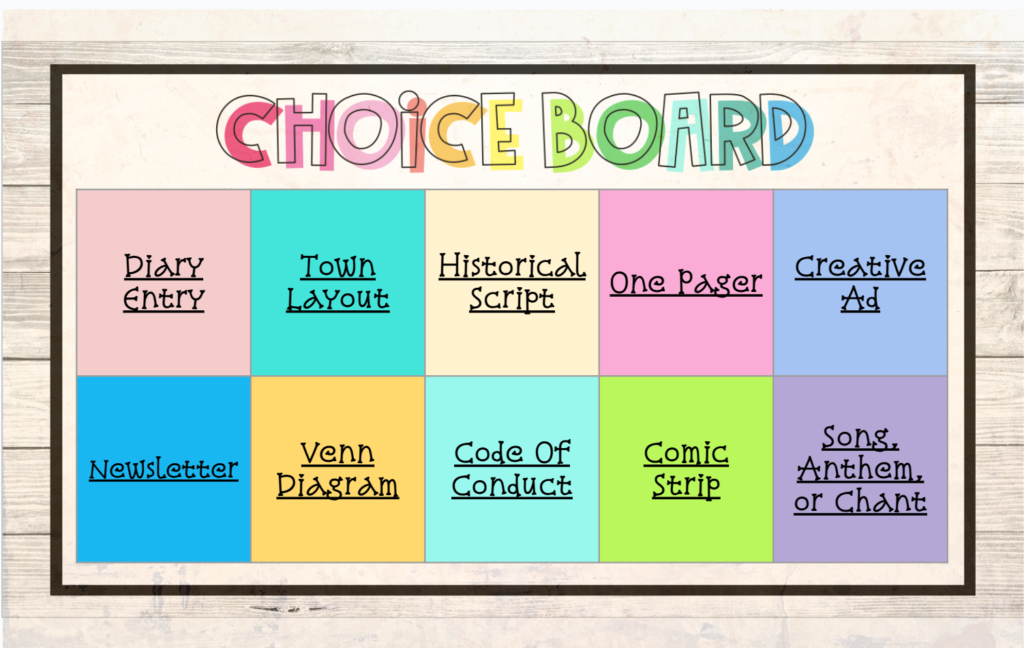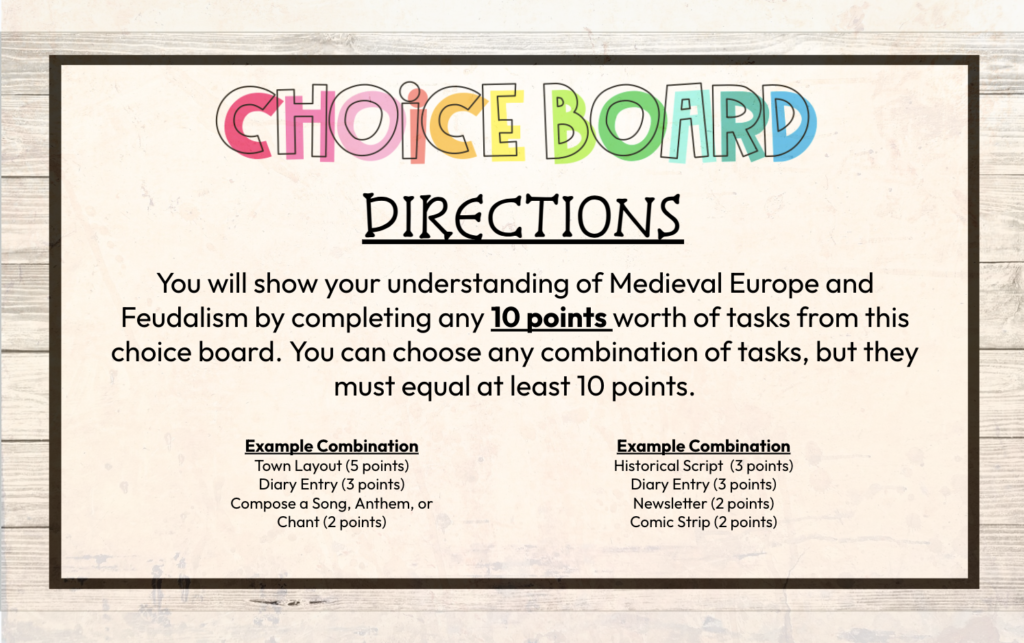Confirming the need for a Teacher and Human Engagement

Artificial intelligence (AI) is increasingly being integrated into education, offering new opportunities and challenges for educators. Let’s focus on the opportunities here. In an effort to keep things novel and foster the greatest learning experiences for my students, I decided to plan a mini unit on the Growth and Development of Medieval Towns solely generated artificially. With the help of my 7th grade Social Studies counterpart, Gifted & Talented Coordinator, and Instructional Coach we put together a week and a half of lessons utilizing AI platforms to optimize the learning experience by varying instructional methods. These tools assisted with streamlining lesson preparation, when we were not able to collaborate and plan together, offering diverse approaches to engage students effectively and ensure the best learning outcomes. In an effort to make it relevant and hook the students, we started the week by watching a clip from Beauty and the Beast Live Action from 2017, “Bonjour” and discussed the Guilds and Medieval architecture on display throughout the number. Followed by analyzing AI generated images to examine historical accuracy, and question authenticity. The rest of the week was a combination of teacher and student led stations, and a choice-board to demonstrate student learning and understanding.
Universal Design for Learning
‘The What’
When planning a unit using AI, it is easy to intertwine the principles of Universal Design for Learning (UDL), which emphasizes providing multiple means of engagement, representation, and action and expression to meet the diverse needs of all learners. This approach aligns with the “what” of learning, ensuring that content is accessible and engaging for every student. ChatGPT was able to come up with Essential Questions and Enduring Understandings based on the NJSLA Standards aligned to the mini unit. Then, it was time to explore various platforms to create engaging lessons that would hook the students in, and motivate them to participate and engage throughout the unit of study. What will be relevant for students? What will be intriguing? What misconceptions may present themselves? The What, then leads to the How.


‘The How’
Utilizing AI in education highlights the “how” of learning, demonstrating innovative methods to deliver content, personalize instruction, and assess student progress. The platforms encouraged students to analyze primary sources, digital media, interpret conversations, decipher the authenticity and historical accuracy of images, and justify choices based on personal preferences. Although there were a few of us creating and working together on this mini-unit, AI platforms served as invaluable assistants, simplifying the creation, modification, and design process of activities with remarkable efficiency. They adeptly cater to the needs of diverse learners, providing a seamless experience in lesson planning and implementation. This is increasingly more important as the abilities in the classroom continue to widen. How to differentiate and meet the needs of all the Tiers? How to foster meaningful conversations? How to expose students to new information and ways of thinking? How to clone yourself to be where every student needs you to be at one time? No simple solution, but AI definitely helps. Lastly, comes the Why.






‘The Why’
Ultimately, integrating AI in education underscores the “why” of learning, emphasizing the importance of preparing students for a future where AI technologies are increasingly prevalent and understanding how to harness these technologies for their benefit. This enables an environment where teachers can continuously provide opportunities of teaching students how to think, not what to think. Finishing with a choice board, offers individualization and voice allowing students to demonstrate understanding of the content and equip them with the knowledge and skills so they can transfer that learning across other disciplines, experiences, and future units of study.



3 Lessons Learned
So here were my 3 big take aways from planning an entire unit with AI:
1. AI Can Support Teachers in Designing Instruction and Assessments to Meet Diverse Student Needs:
-AI tools can help generate ideas and learning materials to address students’ diverse needs, supporting teachers in designing instruction and assessments tailored to individual learners.
-Educators can use AI to provide personalized learning, automate administrative tasks, and improve student outcomes.
-AI can enable writing or improving lessons, as well as the process for finding, choosing, and adapting material for use in lessons.
2. AI Can Enable Individualized Instruction and Personalized Learning:
-AI can assist in individualizing instruction, providing feedback, tutoring, and mentoring tailored to the needs of individual students.
-AI has the potential to automate repetitive tasks and facilitate more personalized learning, catering to multiple different learning styles.
-AI-powered services can increase support available to students with disabilities, multilingual learners, and others who could benefit from greater adaptivity and personalization in digital tools for learning.
3. The Need for Human Oversight and Guidance:
-Despite the capabilities of AI, educators recognize the importance of human oversight and guidance in using AI tools in the classroom.
-Complementary human oversight is still required for tutoring and other uses of generative AI in the classroom.
-Best practices for incorporating AI into the classroom emphasize the need for ongoing research and development, as well as ethical and equitable use of AI in education.
~Adapted from You.com
Works Cited
Edutopia. “Using AI Tools for Differentiated Instruction.” Edutopia, George Lucas Educational Foundation, 6 June 2023., https://www.edutopia.org/article/using-ai-tools-differentiated-instruction/.
Inspiring Inquiry. “AI in the Classroom.” Inspiring Inquiry, n.d., https://www.inspiringinquiry.com/learningteaching/technology/ai-in-the-classroom/.
Noonan, Mary. “3 Ways Educators Can Use Artificial Intelligence.” EdTech Magazine, CDW, 2023, https://edtechmagazine.com/k12/article/2023/11/3-ways-educators-can-use-artificial-intelligence.
Smith, John. “Incorporating Artificial Intelligence into Classroom Examination: Benefits, Challenges, and Best Practices.” eLearning Industry, eLearning Industry, 2023, https://elearningindustry.com/incorporating-artificial-intelligence-into-classroom-examination-benefits-challenges-and-best-practices.
“Universal Design for Learning (UDL).” Center for New Designs in Learning and Scholarship (CNDLS), Georgetown University, URL: https://storage.googleapis.com/cndls-website-media/images/UDL.width-800.png.
U.S. Department of Education. “AI in Education.” Office of Educational Technology, U.S. Department of Education, n.d., https://tech.ed.gov/ai/.
ViewSonic. “AI in Education: 5 Ways It Can Assist Teachers.” ViewSonic Library, ViewSonic,17 Nov. 2022., https://www.viewsonic.com/library/education/ai-in-education-5-ways-it-can-assist-teachers/.
